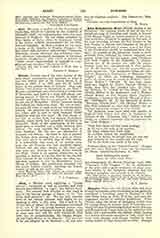

Almagro, DIEGO DE, the ELDER, date and place of birth not satisfactorily established as yet, generally considered a foundling; came to Panama in 1514 with Pedro Arias de Avila (D’Avila), and soon distinguished himself in military expeditions. When Pizarro, upon the return of Andagoya (1522) from his voyage along the western coast of Colombia, conceived the plan of penetrating farther South, Almagro and Hernando de Luciue came to his assistance with funds, and a partnership was formed (1524), leading to a written document executed in 1526, which document both Almagro and Pizarro certified by their marks, neither of them being able to write. Almagro followed after Pizarro on the latter’s tedious voyage of exploration in 1524, rejoining him at the end. In one of his landings Almagro lost an eye by an arrow-shot. He went with Pizarro on the voyage of 1526, during which the first tidings of Peru were obtained on the Ecuadorian coast. He arranged to leave Pizarro to push on farther South, while he returned to Panama for stores and reinforcements. In this manner he twice saved Pizarro and his followers from starvation, but incurred the reproach that, while his associate bore the brunt of dangers and hardships, he led an easy life, sailing back and forth between Panama and the South. Almagro took no part in the action at Caxamarca and the occupation of Cuzco (1532-33). It was Pizarro who until 1535 took the decisive steps both in America and Spain, and performed all the remarkable achievements that characterized the conquest of Peru. It may be that Pizarro cunningly eliminated Almagro from participation in these important transactions, but the latter submitted to it with little protest until 1534, when the landing of Alvarado on the Ecuadorian coast threatened his prospects as well as those of Pizarro. After Alvarado returned to Guatemala, Almagro pressed his claims to a share in the profits of the conquest, and a sort of settlement between him and Pizarro was arrived at in 1535, partly through the efforts of some of the clergy. In consequence of that settlement Almagro undertook his only extended campaign in South America, the ill-conducted and unprofitable journey to Chile. Returning from it in the beginning of 1537, he not only claimed Cuzco as part of his administrative domain, but seized it by force of arms and defeated a body of Spanish troops faithful to Pizarro at Abancay (April 17). And thus began the bloody troubles among the Spaniards that disturbed Peru for nearly twenty years afterwards. Hernando Pizarro (brother of Francisco) was taken prisoner by Almagro, but released. In the course of the hostilities that followed Almagro was defeated at Salinas near Cuzco, on the 26th of April, 1538, and was shortly afterwards executed, while a prisoner. Almagro is usually represented as a more noble character than Pizarro. What can be affirmed is that he was greatly his inferior in ability. More pleasant in intercourse, careless and weak in many respects, his whole career in South America was that of an auxiliary who bethought himself of his own interests when it was too late. His conduct on the expedition to Chile showed no great talent as a leader, nor any of the traits of a chivalrous nature with which he is usually credited.—DIEGO, the YOUNGER, a natural son of the preceding and of an Indian woman from Panama. Francisco Pizarro took considerable interest in young Almagro, keeping him near his person at Lima. The chief followers of the elder Almagro, after his execution, gathered around the young man in a conspiracy to put Pizarro out of the way, which deed was consummated June 26, 1541, at Lima, the assassins assembling for the purpose at Almagro’s house. After Pizarro’s death young Almagro was proclaimed Governor of Peru by his party, but Cristoval Vaca de Castro, the royal delegate, was already in the field against him. On the 16th of September, 1542, the opposing parties met at Chupas, and after a long and bloody engagement the troops of Almagro were completely defeated, and their young leader taken prisoner. He was shortly afterwards executed at Cuzco. With him the name of Almagro became extinct in Peru.
AD. F. BANDELIER

